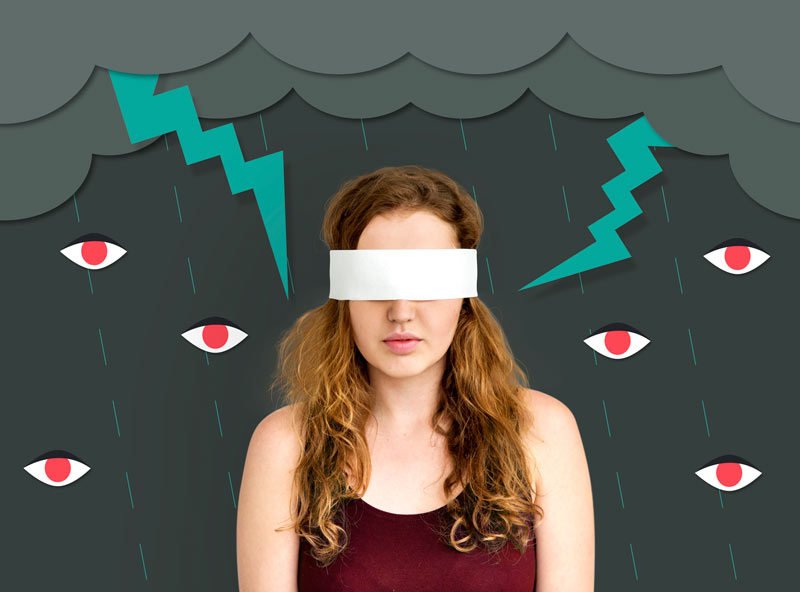Understanding Bipolar Disorder: Can Someone Realize They Are Bipolar?
Understanding Bipolar Disorder: Can Someone Realize They Are Bipolar?

In the realm of mental health, few conditions are as enigmatic and impactful as bipolar disorder. Recognizing the intricacies of this disorder is not only crucial for those who may be directly affected but also for society as a whole. In this blog, we embark on a journey to unravel the mysteries surrounding bipolar disorder. We invite you to accompany us on this enlightening quest as we address a fundamental question: Can individuals genuinely discern if they are grappling with bipolar disorder?
Join us as we navigate this multifaceted topic and uncover the vital insights that can lead to better awareness and management.
Introduction: Exploring Bipolar Disorder
Bipolar disorder, often referred to as manic-depressive illness, is a complex mental health condition characterized by extreme shifts in mood, energy, and behavior. It stands as a significant challenge not only for those directly affected but also for their families, friends, and society at large. This condition can manifest in distinct phases: the manic phase, marked by heightened energy, euphoria, and impulsivity, and the depressive phase, characterized by profound sadness, low energy, and a sense of hopelessness. These fluctuations can be disruptive and have a profound impact on an individual’s daily life, relationships, and overall well-being.
Amidst the multifaceted nature of bipolar disorder, a critical question emerges: Can someone genuinely recognize the signs and symptoms of bipolar disorder within themselves? Exploring this question is essential as it paves the way for early intervention and appropriate management. In this article, we will navigate through the nuances of bipolar disorder, exploring its various facets and providing insights into the self-awareness aspect, aiming to shed light on whether individuals can, indeed, discern if they are grappling with this challenging condition.
Recognizing Bipolar Disorder Symptoms
Recognizing bipolar disorder hinges on understanding its hallmark symptoms and the distinct phases that individuals with the condition may experience. Common symptoms of bipolar disorder encompass a wide spectrum of emotional and behavioral changes. During the manic phase, individuals often exhibit increased energy, reduced need for sleep, grandiosity, racing thoughts, and impulsivity. They might engage in risky behaviors, such as excessive spending or reckless driving. On the flip side, the depressive phase brings forth symptoms like persistent sadness, loss of interest in previously enjoyed activities, changes in appetite and sleep patterns, feelings of worthlessness, and even thoughts of suicide.
These symptoms do not always occur in isolation, and their severity can vary from person to person. Recognizing bipolar disorder entails identifying patterns of mood swings, the frequency and duration of these episodes, and their impact on daily functioning. By comprehending the distinct indicators associated with mania and depression, individuals and their loved ones can begin to discern the presence of bipolar disorder and seek appropriate evaluation and treatment, a crucial step in managing this condition effectively.
Self-Awareness and Bipolar Disorder
Self-awareness plays a pivotal role in recognizing bipolar disorder, but it’s a nuanced process. Many individuals with bipolar disorder may not immediately grasp the full extent of their symptoms, especially during manic phases when they might feel exceptionally confident or during depressive phases when self-esteem can plummet. However, over time, some individuals may begin to notice recurring patterns in their mood and behavior. They might realize that their emotional fluctuations are more extreme and frequent than those of their peers. It’s not uncommon for loved ones or close friends to provide valuable insights as well, pointing out changes in behavior or mood that the affected person may not have noticed themselves.
For example, someone might retrospectively recall periods of excessive energy and impulsivity during manic episodes, followed by prolonged periods of deep sadness and disinterest in activities they once enjoyed during depressive episodes. These realizations, along with the recognition of the detrimental impact of these mood swings on various aspects of their life, can prompt individuals to seek professional evaluation. Self-awareness, when combined with support from mental health professionals and loved ones, is a crucial first step in effectively managing bipolar disorder and improving overall quality of life.
Seeking Professional Help: Diagnosis and Treatment
Recognizing the signs of bipolar disorder is an essential initial step, but the journey toward effective management often requires professional guidance. Seeking help from mental health professionals, such as psychiatrists or clinical psychologists, is of paramount importance to obtain a precise diagnosis. Bipolar disorder can sometimes be misdiagnosed as other conditions, making it imperative to consult an expert who can conduct a thorough evaluation, including a detailed psychiatric history, mood assessments, and in some cases, laboratory tests. An accurate diagnosis is the foundation upon which an individual can build an effective treatment plan tailored to their specific needs.
Once diagnosed, individuals with bipolar disorder have access to a range of treatment options, including medication, psychotherapy, and lifestyle modifications. Medications, such as mood stabilizers and antipsychotics, can help manage the extreme mood swings associated with bipolar disorder. Psychotherapy, including cognitive-behavioral therapy (CBT) and interpersonal therapy, can provide individuals with essential coping skills and strategies to manage their condition effectively.
Additionally, adopting a stable daily routine, engaging in regular exercise, and maintaining a supportive social network can all contribute to symptom management and overall well-being. By emphasizing the importance of professional help and highlighting the diverse treatment approaches available, individuals can take positive steps toward effectively managing bipolar disorder and leading fulfilling lives.
Unveiling Uncommon Types of OCD: Beyond the Ordinary
Unveiling Uncommon Types of OCD: Beyond the Ordinary

Imagine a world where the mind weaves intricate patterns, sometimes steering us into unexpected territories. In this blog, we will get deeper into the lesser-known dimensions of OCD – those that often whisper while the more familiar traits shout. While you’re likely acquainted with the typical portrayals involving cleanliness rituals and repetitive behaviors, there exists an entire spectrum of uncommon OCD types that are equally fascinating. Join us as we peel back the layers, venturing into the extraordinary intricacies that lie beneath the surface. Together, we’ll delve into the heart of “Unveiling Uncommon Types of OCD: Beyond the Ordinary,” where the rich tapestry of human emotions meets the complexities of a condition that never ceases to amaze.
The Intrusive Taboo Thoughts (Taboo OCD)
Within the diverse tapestry of Obsessive-Compulsive Disorder (OCD), a particular thread weaves a unique pattern – the enigmatic presence of intrusive taboo thoughts. This lesser-explored facet of OCD introduces us to a complex world where the mind, often against one’s own wishes, conjures up thoughts that dance on the edges of societal taboos. These thoughts might encompass topics ranging from violence and aggression to taboo desires or forbidden impulses.
At the heart of this experience lies a profound paradox. Individuals grappling with intrusive taboo thoughts are often among the last to endorse or act on such thoughts in real life. However, the mere existence of these thoughts can become a source of distress and confusion. The clash between these intrusive mental fragments and one’s personal values creates a battleground for intense emotions, including guilt, shame, and fear. This inner struggle frequently leads to compulsive behaviors and mental rituals in an attempt to neutralize the discomfort these thoughts evoke. By delving into the world of intrusive taboo thoughts, we gain insights into the complexities of OCD that extend beyond the conventional perceptions of the disorder.
Perfect Symmetry Obsessions and Compulsions
Individuals navigating this form of OCD find themselves entangled in an unrelenting pursuit of equilibrium, where asymmetry becomes an adversary to be conquered. The desire for symmetry goes beyond mere aesthetics; it becomes an all-consuming compulsion that can dictate the rhythm of daily life.
For those with perfect symmetry obsession, the world is a canvas to be meticulously arranged. A misplaced object or an uneven step can trigger an unsettling dissonance, often sparking a cascade of anxious thoughts. The intricate rituals that follow, while aimed at achieving alignment, can paradoxically lead to further distress. From rearranging personal belongings to adjusting body postures, the compulsions are as varied as they are relentless. The impact is not only confined to time and energy but also to the emotional toll of feeling trapped in a constant struggle for balance.
Just-Right OCD: The Quest for Utmost Precision
The hallmark of “just-right” OCD lies in the persistent feeling that something is amiss unless a specific order is attained. This compulsion to ensure things are precisely in their rightful place can lead to a cycle of repetitive actions that disrupt daily routines. From adjusting the angle of a picture frame to aligning objects with imaginary lines, these rituals stem from an intense need for internal equilibrium. However, this quest for perfection often brings anything but contentment. The frustration and distress that accompany the relentless pursuit of the “just-right” sensation can profoundly impact an individual’s emotional well-being and quality of life. By delving into the world of “just-right” OCD, we uncover the intricate mechanisms that drive individuals to seek harmony, even in the smallest details, in a world that rarely adheres to such rigid definitions.
Existential OCD: Navigating the Philosophical Intricacies
Within the intricate tapestry of Obsessive-Compulsive Disorder (OCD), an often-overlooked thread weaves a profound narrative – the realm of existential OCD. Imagine a mind grappling not only with the ordinary challenges of daily life but also with philosophical quandaries that probe the very essence of existence. Individuals ensnared in this unique form of OCD are burdened by obsessions centered around questions of purpose, identity, and the ultimate meaning of life itself.
Existential OCD is a symphony of anxiety-driven ruminations that delve into the philosophical unknown. Thoughts may revolve around morality, the afterlife, or the nature of reality, and these individuals are tormented by the fear that failing to find definitive answers will have dire consequences. This leads to compulsive behaviors, ranging from constant researching to elaborate rituals aimed at appeasing the existential turmoil. The paradox lies in the nature of seeking certainty in matters that are inherently uncertain.
The emotional strain of navigating profound questions in addition to everyday life can be overwhelming, often leaving individuals feeling lost in a sea of relentless contemplation. By embarking on a journey through the intricate layers of existential OCD, we glimpse the extraordinary weight of philosophical obsessions and the lengths individuals go to in their quest for a semblance of meaning in a universe fraught with ambiguity.
Common Mental Health Disorders Among Adults
Common Mental Health Disorders Among Adults

In today’s fast-paced world, understanding the intricate landscape of mental well-being is paramount. This blog will delve into a range of common mental health disorders that impact adults, shedding light on their manifestations, underlying causes, and potential pathways to recovery. From anxiety and mood disorders to psychotic conditions and trauma-related issues, we embark on a journey to demystify these challenges. By fostering awareness and comprehension, we strive to contribute to a more empathetic and supportive society that values mental health as an integral part of overall well-being.
Understanding the Spectrum of Anxiety Disorders
Anxiety disorders cast a substantial shadow over the landscape of adult mental health, presenting a diverse spectrum of challenges that individuals grapple with. Within this domain, several distinct conditions loom, each with its own unique characteristics. Generalized Anxiety Disorder (GAD) often manifests as persistent and excessive worry, extending beyond specific triggers. Panic Disorder, on the other hand, is characterized by intense and abrupt surges of fear, accompanied by physical sensations like a racing heart or shortness of breath. Social Anxiety Disorder involves an overwhelming fear of judgment and scrutiny in social situations, while Specific Phobias entail an irrational dread of particular objects or scenarios.
The root causes of anxiety disorders are intricate and multifaceted, intertwining genetic predispositions, environmental factors, and brain chemistry. Symptoms can range from cognitive manifestations like intrusive thoughts to physical sensations such as rapid heartbeat or trembling. Nevertheless, hope exists in the realm of treatment. Psychotherapy, cognitive-behavioral therapy (CBT), and medication can all play crucial roles in managing these disorders. By delving into the causes, symptoms, and potential interventions for each distinct anxiety disorder, we can gain a deeper understanding of the intricate fabric of anxiety-related conditions. This understanding not only empowers those affected but also fosters a more empathetic and supportive environment for individuals navigating the challenges of anxiety disorders in adulthood.
Navigating Through the Depths of Mood Disorders
Mood disorders cast a profound shadow over the emotional landscape of adulthood, wielding the power to profoundly impact an individual’s overall well-being. Among the most prevalent of these disorders are Major Depressive Disorder (MDD) and Bipolar Disorder, each presenting a distinct tapestry of emotional upheaval. Major Depressive Disorder is marked by persistent feelings of sadness, hopelessness, and a loss of interest or pleasure in activities that were once enjoyed. On the other side of the spectrum, Bipolar Disorder introduces alternating episodes of manic highs and depressive lows, creating a rollercoaster of emotional states that can challenge one’s ability to function.
These disorders dig deep into the core of an individual’s emotional experience, impacting relationships, work, and daily life. Understanding the underlying factors contributing to these mood disorders involves a complex interplay of genetics, brain chemistry, and life experiences. Tailored interventions are essential to addressing the distinct challenges posed by each disorder. Psychotherapy, medication, lifestyle changes, and support networks all play a crucial role in managing and mitigating the impact of mood disorders.
Deciphering the Mind: Psychotic Disorders Unveiled
The realm of psychotic disorders offers a glimpse into the intricate workings of the human mind, where perception and reality intermingle in complex ways. These disorders disrupt an individual’s grasp on reality, giving rise to experiences that challenge the very foundation of their understanding. Hallucinations, where one perceives sensory stimuli that aren’t actually present, and delusions, characterized by strongly held false beliefs despite contradictory evidence, stand as prominent hallmarks of these conditions.
Schizophrenia, a well-known example within this category, often features a combination of disorganized thinking, emotional blunting, and disturbances in speech and behavior. Schizoaffective Disorder combines elements of mood disorders and schizophrenia, leading to a fusion of mood swings and psychosis. Delusional Disorder, meanwhile, revolves around persistent, non-bizarre delusions that can significantly impact an individual’s daily life.
Unraveling Trauma and Stressor-Related Disorders
The impact of trauma and distressing experiences on mental health is undeniable, often leaving lasting imprints that extend far beyond the initial event. Trauma and stressor-related disorders serve as poignant reminders of the intricate connections between our life experiences and our psychological well-being. These disorders can arise from exposure to a range of traumatic events, such as accidents, violence, natural disasters, or personal loss, which can profoundly disrupt an individual’s sense of safety and stability.
Post-Traumatic Stress Disorder (PTSD) stands out as one of the most recognized conditions within this category. It manifests as a complex interplay of distressing symptoms, including intrusive thoughts, nightmares, hyperarousal, and avoidance behaviors, all stemming from past traumatic experiences. Acute Stress Disorder, on the other hand, presents similar symptoms, but typically emerges in the immediate aftermath of a traumatic event and tends to resolve within a shorter timeframe.
Delving into the intricacies of trauma and stressor-related disorders requires a deep exploration of both the psychological and physiological effects of trauma. The brain’s response to stress, the role of memory, and the impact of individual resilience all contribute to the way these disorders manifest and are managed. Various therapeutic approaches, including cognitive-behavioral therapy (CBT), exposure therapy, and eye movement desensitization and reprocessing (EMDR), offer avenues for recovery and healing.
Identifying Red Flags of Bipolar Disorder: Warning Signs to Watch For
Identifying Red Flags of Bipolar Disorder: Warning Signs to Watch For

in this blog, we will analyze the symptoms and signals to address bipolar disorder, shedding light on the subtle indicators that can alert us to its presence. Bipolar disorder, a condition characterized by extreme mood shifts between manic highs and depressive lows, affects individuals across the globe. While each person’s experience is unique, recognizing common warning signs is paramount for timely intervention and effective management. Join us as we delve into the nuances of bipolar disorder and equip ourselves with the knowledge needed to identify those red flags that may pave the way for understanding, support, and healing.
Understanding Bipolar Disorder: What You Need to Know
Bipolar disorder is a complex and multifaceted mental health condition that significantly impacts an individual’s emotional well-being and overall quality of life. This disorder is characterized by alternating episodes of extreme mood states, known as manic and depressive phases. During manic episodes, individuals may experience heightened energy levels, an inflated sense of self-confidence, and a decreased need for sleep. These periods can be accompanied by impulsive decision-making, increased talkativeness, and engagement in risky behaviors.
On the other hand, depressive episodes are marked by overwhelming sadness, loss of interest or pleasure in previously enjoyed activities, changes in appetite or sleep patterns, and a pervasive feeling of hopelessness.
Bipolar disorder’s prevalence is substantial, affecting people of all ages, genders, and backgrounds. Its impact extends beyond the individual, influencing relationships, work performance, and daily functioning. Early detection and intervention are crucial in managing the disorder effectively. Detecting red flags during the initial stages can lead to timely treatment, reducing the severity of symptoms and preventing potential complications. As we proceed, we will delve deeper into the specific red flags associated with both manic and depressive episodes, equipping you with the knowledge needed to recognize these signs and take appropriate action.
Red Flags of Bipolar Disorder: Recognizing Manic Episode Signs
Manic episodes, a defining feature of bipolar disorder, are periods characterized by an intense surge of energy, heightened mood, and an exaggerated sense of self-importance. During these phases, individuals might find themselves engaging in a flurry of activities, often taking on more than they can handle. They may display an uncharacteristic restlessness, talk rapidly, and struggle to focus on a single task due to racing thoughts. Heightened irritability is also a common manifestation, leading to conflicts and strained relationships.
Recognizing red flags associated with manic episodes is crucial for both individuals experiencing these symptoms and their loved ones. Increased energy levels that seem disproportionate to the individual’s usual behavior can be an initial indicator. Other red flags include a decreased need for sleep, with individuals feeling energetic even after minimal rest. Impulsivity and poor judgment might lead them to make hasty decisions with potential long-term consequences. Additionally, engaging in risky behaviors, such as excessive spending, reckless driving, or substance abuse, can be prominent signs of a manic episode.
To better grasp these red flags, let’s explore real-life examples. Consider an individual who suddenly takes on multiple ambitious projects simultaneously, barely sleeping, and displaying uncharacteristic bursts of irritability when questioned about their actions. Another example might involve someone exhibiting extreme impulsivity by making impulsive purchases, engaging in casual sexual encounters, or pursuing impromptu and potentially dangerous travel plans.
Identifying Red Flags of Bipolar Disorder: Depressive Episode Indicators
Depressive episodes, the other side of the bipolar disorder spectrum, bring about a profound shift in mood characterized by overwhelming sadness and a persistent feeling of emptiness. During these phases, individuals often experience a loss of interest or pleasure in activities that once brought them joy. They may withdraw from social interactions, experiencing a sense of isolation even when surrounded by others. Sleep disturbances, either in the form of excessive sleep or insomnia, coupled with changes in appetite and weight, are common telltale signs. Feelings of fatigue and low energy levels can make even simple daily tasks feel insurmountable, contributing to a sense of hopelessness.
Recognizing red flags associated with depressive episodes is essential for early intervention and support. Persistent sadness that lasts for an extended period, beyond the typical ups and downs of life, is a significant indicator. An inability to find pleasure in hobbies, previously enjoyed activities, or social interactions may signal the presence of a depressive episode. Disrupted sleep patterns, such as sleeping excessively or struggling with insomnia, can exacerbate feelings of despair. Additionally, fluctuating appetite and energy levels, often resulting in significant changes in weight, can accompany these episodes.
When to Seek Help: Taking Action on Red Flags
Recognizing the red flags of bipolar disorder is just the first step on the journey towards effective management and well-being. If you or someone you care about displays these warning signs, seeking professional help is of paramount importance. Mental health professionals possess the expertise needed to accurately diagnose and develop personalized treatment plans that cater to an individual’s unique needs.
The diagnostic process for bipolar disorder typically involves comprehensive assessments and evaluations conducted by trained mental health experts. These assessments consider various factors, including the individual’s medical history, symptom duration and intensity, and the impact of symptoms on daily life. The insights gained from these evaluations guide the development of an appropriate treatment strategy, which may include a combination of therapy, medication, and lifestyle modifications.
Maintaining open lines of communication with friends, family, and healthcare providers is pivotal. Engaging in candid discussions about your experiences can facilitate understanding and empathy, creating a supportive environment that fosters recovery. Encourage loved ones to learn about bipolar disorder to gain insight into the challenges you or others may face. Remember, seeking help is a sign of strength, and by taking proactive steps to address red flags, you’re taking control of your mental health journey and working towards a more balanced and fulfilling life.
Is Depression a Geriatric Syndrome? Exploring Mental Health in Older Adults
Is Depression a Geriatric Syndrome? Exploring Mental Health in Older Adults

Embarking on an enlightening journey into the realm of mental health among older adults, we delve into the thought-provoking question: Is Depression a Geriatric Syndrome? In this exploration, we aim to bridge the gap between professional insights and relatable understanding, unraveling the intricate relationship between aging and mental well-being. As we navigate through the complexities of geriatric syndromes, our focus rests on shedding light on the unique challenges that depression presents within the older adult population.
Understanding Geriatric Syndromes: A Holistic Approach to Senior Health
Geriatric syndromes, a term embracing a spectrum of interconnected issues, paint a holistic portrait of senior health. These syndromes often blur the lines between medical disciplines, reflecting the intricate nature of aging. From frailty and falls to cognitive decline and mood disorders, the intricate dance of geriatric syndromes challenges traditional categorizations. Of special significance is depression, a sentinel of mental well-being, which often surfaces in the wake of other health challenges.
This holistic approach acknowledges that each facet of health, be it physical or emotional, is a thread in the fabric of well-being. As we navigate through the dimensions of geriatric syndromes, we unravel a tale of interconnectedness, urging us to perceive senior health through a lens that encompasses the whole person.
The Complex Connection: Depression and Geriatric Health
Late-life depression, while influenced by biological changes, is an intricate interplay of various elements. Biological shifts, such as alterations in neurotransmitter levels and hormonal changes, can create a predisposition for depressive symptoms. Beyond biology, social factors like isolation and loneliness cast their shadows, as changing life circumstances or loss of loved ones can fuel the onset of depression. Moreover, the presence of medical conditions—ranging from chronic pain to cardiovascular issues—can intertwine with depressive symptoms, creating a complex tapestry of geriatric health challenges. Recognizing the distinct nuances that shape depression in older adults is essential, as it calls for a tailored approach to diagnosis and treatment.
By delving into the intricacies of this complex connection, we seek to illuminate the path towards understanding, empathy, and effective management of depression within the broader scope of geriatric health.
Unveiling the Impact: Depression as a Key Geriatric Syndrome
Depression in the aging population can cast a shadow that reaches far beyond emotional well-being. Cognitive function, a pillar of vitality, can be eroded by the presence of depression, leading to memory difficulties, reduced concentration, and even an increased risk of dementia. Physical health also bears the weight, as depression has been linked to an array of medical conditions, including cardiovascular diseases and weakened immune responses. Therefore, the quality of life itself becomes entwined with depression’s grasp, influencing social interactions, personal fulfillment, and overall life satisfaction.
Through real-life stories and insights from experts, we will navigate the labyrinthine landscape of identifying and addressing depression in older adults. By illuminating the broader impact of depression as a key geriatric syndrome, we strive to enhance awareness, foster empathy, and pave the way for a more comprehensive approach to holistic well-being in the aging population.
Beyond the Blues: Differentiating Depression from Normal Aging
Normal aging often brings forth a range of emotions, shaped by life experiences and changing circumstances. Feelings of occasional sadness or fleeting moments of melancholy are not uncommon as one traverses the stages of life. However, the distinction emerges in the persistence, intensity, and breadth of these emotions. While some degree of adjustment to life’s changes is expected, clinical depression manifests as a persistent cloud that obscures the joy, leaving individuals grappling with prolonged sadness, hopelessness, and a loss of interest in activities that once brought pleasure.
With that being said, it is important to mention that sleep disturbances, changes in appetite, and difficulty concentrating can further signal the presence of clinical depression, setting it apart from the transient shifts in mood that often accompany aging.
Empowering Geriatric Mental Health: Strategies for Prevention and Support
Prevention becomes a cornerstone as we embark on the journey of safeguarding mental well-being. Engaging in regular physical activity, nurturing social connections, and embracing a balanced diet rich in nutrients that support brain health can collectively fortify mental resilience. Moreover, cultivating mindfulness through practices like meditation and yoga can serve as a shield against the potential impact of stressors that often accompany aging. Recognizing the significance of early intervention, we also explore the role of regular check-ups and mental health screenings in identifying potential concerns before they gain a foothold.
When the shadows of depression do linger, support strategies come to the forefront, offering a lifeline of compassion and care. Engaging in talk therapy, such as cognitive-behavioral therapy (CBT), can provide individuals with valuable tools to navigate through depressive symptoms. Additionally, fostering connections through support groups and peer networks can alleviate feelings of isolation, providing a safe space to share experiences and insights. When necessary, medication under the guidance of a healthcare professional can complement other approaches, aiding in the journey toward mental wellness.
In the realm of geriatric mental health, empowerment takes root in knowledge, proactive choices, and a network of support. By embracing these strategies, we endeavor to not only promote mental well-being but also to elevate the quality of life for older adults and those who care for them.
The Most Common Anxiety Disorder in Youth
The Most Common Anxiety Disorder in Youth

Anxiety disorders in youth have garnered significant attention due to their potential to influence various aspects of life, from academic performance to social interactions. By examining the prevalence and impact of the most common anxiety disorder, we aim to provide a clearer picture of its effects on young minds and emphasize the importance of proactive measures for early detection and effective management. Join us as we navigate through the intricacies of this topic, unraveling valuable insights that empower both individuals and their support networks with the knowledge to foster a mentally resilient youth population.
Introduction to Anxiety Disorders in Youth
In the intricate landscape of mental health, anxiety disorders stand out as a significant concern, especially when it comes to the younger population. Adolescence and early adulthood are crucial developmental stages marked by various challenges and transitions, making them susceptible to experiencing heightened levels of anxiety. Anxiety disorders encompass a range of conditions, each with its unique characteristics, but they collectively share the common thread of inducing excessive worry, fear, and apprehension that can significantly impact daily functioning.
Anxiety disorders in youth can manifest in different ways, from excessive worrying about school performance or social interactions to physical symptoms like restlessness, irritability, and sleep disturbances. It’s important to recognize that occasional feelings of anxiety are a natural part of life, but when they become persistent, overwhelming, and interfere with daily life, they may signify an underlying anxiety disorder that requires attention. As we delve into the prevalence and impact of the most common anxiety disorder among young individuals, we’ll uncover the nuances of these conditions and the potential long-term effects they can have on mental well-being, relationships, and overall quality of life.
By gaining a deeper understanding of anxiety disorders in youth, we equip ourselves with the tools to provide timely support, foster open conversations, and ultimately contribute to a healthier and happier future generation.
Unveiling Generalized Anxiety Disorder (GAD)
Generalized Anxiety Disorder (GAD) emerges as a prominent player within the realm of anxiety disorders, leaving a profound impact on the lives of many young individuals. Characterized by persistent and excessive worry about a variety of everyday situations and concerns, GAD often presents a formidable challenge that can significantly disrupt daily routines and overall well-being. Unlike normal worries that may come and go, GAD tends to linger, creating a constant state of unease that can be mentally and physically draining.
Individuals grappling with GAD often find themselves caught in a cycle of overthinking and heightened tension, regardless of whether a specific trigger is present or not. This unrelenting worry can extend to multiple facets of life, such as academic performance, relationships, health concerns, and even future uncertainties. The emotional toll of GAD may manifest as irritability, restlessness, and difficulty concentrating, further amplifying the distress experienced. Understanding the intricacies of GAD is crucial, as it not only helps us recognize its distinct signs and symptoms but also underscores the urgency of early intervention. By delving into the nuances of GAD, we aim to shed light on this prevalent anxiety disorder, dispel misconceptions, and highlight the significance of seeking professional help and support for affected youth.
Factors Contributing to GAD in Youth
The development of Generalized Anxiety Disorder (GAD) in youth is a complex interplay of various factors that span both biological and environmental realms. Genetics can play a significant role, as individuals with a family history of anxiety disorders may be more predisposed to experiencing GAD. Additionally, neurochemical imbalances involving neurotransmitters like serotonin and dopamine can contribute to the onset of GAD, influencing the brain’s response to stress and anxiety-inducing situations.
Environmental triggers also hold considerable sway in the emergence of GAD among young individuals. The pressures of modern life, such as academic expectations, peer interactions, and social media influences, can create a fertile ground for the development of excessive worry and anxiety. Moreover, adverse childhood experiences, trauma, and family dynamics can shape the emotional landscape and contribute to the development of GAD. In this intricate web of influences, it’s important to recognize that no single factor operates in isolation. Rather, it’s the convergence of these biological, genetic, and environmental elements that may pave the way for GAD.
Addressing GAD: Strategies and Support for Youth
When it comes to tackling Generalized Anxiety Disorder (GAD) in youth, a multifaceted approach encompassing various strategies and robust support systems is paramount. Cognitive-behavioral therapy (CBT) stands out as a well-established and effective therapeutic approach. Through CBT, young individuals learn to identify and reframe negative thought patterns, develop coping mechanisms, and acquire valuable skills to manage anxiety-provoking situations. This evidence-based approach empowers youth to regain a sense of control over their thoughts and emotions, equipping them with invaluable tools to navigate the challenges posed by GAD.
In addition to therapy, lifestyle adjustments play a pivotal role in managing GAD. Regular physical activity, adequate sleep, and a balanced diet contribute to overall well-being and can help alleviate symptoms of anxiety. Mindfulness and relaxation techniques, such as deep breathing exercises and meditation, offer practical ways to reduce stress and promote emotional equilibrium. Creating a supportive environment is equally crucial – involving parents, educators, and peers in the process can foster understanding and empathy, enabling young individuals to feel validated and less isolated in their struggles.
The Role of Early Intervention and Prevention
Early intervention and prevention strategies are pivotal components in addressing Generalized Anxiety Disorder (GAD) among youth, offering the potential to mitigate its impact and pave the way for healthier mental well-being. Recognizing the signs of GAD in its early stages is crucial, as it allows for timely intervention before the disorder escalates and becomes entrenched in daily life. When addressed promptly, GAD may be more responsive to treatment and less likely to result in long-term adverse outcomes.
Preventive measures also hold significant promise in reducing the risk of GAD’s onset. Equipping young individuals with effective stress management techniques, emotional resilience skills, and healthy coping mechanisms can bolster their ability to navigate the challenges that often contribute to anxiety. Schools, families, and communities can play an instrumental role in promoting mental health awareness and destigmatizing seeking help.
Unveiling the Early Signs of Schizophrenia in Adults
Unveiling the Early Signs of Schizophrenia in Adults

Schizophrenia, a complex and often misunderstood condition, can impact individuals in various ways, and early detection is paramount for timely intervention and effective management. Throughout this blog, we empower you with the knowledge to recognize behavioral, cognitive, emotional, and interpersonal shifts that could potentially indicate the presence of schizophrenia. By equipping ourselves with this understanding, we pave the way for informed decisions and compassionate support, fostering a path towards mental well-being.
Recognizing Behavioral Changes
When it comes to schizophrenia in adults, being attuned to these behavioral changes is of paramount importance. One of the primary behavioral red flags is a noticeable alteration in social engagement. Individuals might start withdrawing from social activities, isolating themselves from friends, family, and social gatherings that once brought them joy. This withdrawal can manifest as a decrease in communication, reluctance to participate in conversations, and an overall decline in the desire to connect with others. Additionally, changes in personal hygiene and self-care routines may become evident. Neglecting grooming habits or displaying a lack of interest in maintaining one’s appearance could signal a potential shift in mental well-being.
Another behavioral aspect to watch for is a disruption in daily routines. Schizophrenia might lead to erratic changes in sleep patterns, appetite, and overall daily structure. Individuals could experience insomnia or oversleeping, sudden fluctuations in weight, and a loss of interest in activities they previously enjoyed. These disruptions can have a cascading effect on their ability to function optimally in both personal and professional spheres.
Cognitive Transformations to Watch For
One of the notable cognitive changes is the alteration in thinking patterns. Individuals could begin experiencing disorganized thinking, struggling to maintain coherent and logical thoughts. This might manifest as difficulty in expressing ideas coherently, jumping between unrelated topics, or even incorporating tangential and illogical connections into their speech. Such shifts can impact their ability to effectively communicate and engage in meaningful conversations, often leading to confusion among those interacting with them.
Furthermore, perceptual alterations can offer critical insights into potential mental health concerns. Individuals may start experiencing distortions in their perception of reality, leading to perceptual disturbances known as “hallucinations.” These hallucinations can affect any of the senses, causing individuals to see, hear, feel, taste, or smell things that aren’t actually present. Additionally, they might develop “delusions,” which are false beliefs that persist despite evidence to the contrary. Delusions can take various forms, such as believing in paranoid ideas, grandiose notions, or even feeling controlled by external forces.
Emotional Telltale Signs
One prominent emotional red flag is the sudden and unexplained shift in mood. Individuals might experience intense mood swings, oscillating between periods of euphoria, irritability, or sadness without a clear external trigger. These erratic emotional fluctuations can be perplexing not only for the individuals themselves but also for those around them, highlighting the importance of understanding their potential connection to mental health concerns.
Moreover, a decline in emotional expression can signal a deeper emotional disturbance. Individuals might exhibit a reduced range of emotional expression, appearing emotionally flat or detached from situations that would typically evoke a response. This phenomenon, known as “blunted affect,” can manifest as a lack of facial expressions, diminished vocal inflections, and an overall sense of emotional disconnect. Friends, family, and coworkers may notice this change in emotional responsiveness, prompting a need for careful consideration and support.
Navigating Social and Interpersonal Shifts
The intricacies of schizophrenia extend beyond individual experiences, often revealing their presence through shifts in social dynamics and interpersonal interactions. Recognizing and understanding these changes is pivotal in deciphering the early signs of the disorder. A noticeable alteration in social engagement is a key aspect to watch for. Individuals might gradually withdraw from social circles, displaying reduced interest in once-enjoyed social activities and conversations. This withdrawal can lead to a sense of isolation, both for the individual and their loved ones, as meaningful connections and interactions become less frequent. As a result, fostering open lines of communication and maintaining a supportive network is essential in navigating these shifting social landscapes.
Additionally, changes in the perception of relationships and interactions might come to the forefront. Individuals at the onset of schizophrenia could exhibit difficulty in maintaining meaningful relationships due to their altered perceptions of trust and reality. They might develop unfounded suspicions or paranoia, making it challenging to engage in healthy, reciprocal relationships. Friends and family might notice increased skepticism, withdrawal from emotional connections, and reluctance to share thoughts or experiences. By sensitively navigating these social and interpersonal shifts, those close to the individual can contribute to creating an environment of understanding and empathy, fostering a supportive foundation for addressing potential schizophrenia-related concerns.
Conclusion
At Interborough Mental Health Institute, we stand as a beacon of support and expertise, committed to providing compassionate care and evidence-based solutions for those navigating the complexities of mental health challenges. Our team of dedicated professionals is equipped with the understanding and experience needed to guide individuals and their loved ones through the intricate landscape of schizophrenia. With a holistic approach that encompasses behavioral, cognitive, emotional, and interpersonal dimensions, we empower individuals to take proactive strides towards early detection, intervention, and management.
Decoding the Age of OCD Diagnosis: Unveiling Common Timelines and Patterns
Decoding the Age of OCD Diagnosis: Unveiling Common Timelines and Patterns

Within the realm of Obsessive-Compulsive Disorder (OCD) research, this blog delves into an intricate analysis of the age-related dynamics surrounding its diagnosis. The focal point lies in deciphering the prevalent patterns and timelines that dictate the emergence of OCD. With a tone that resonates professionalism and a commitment to accessibility, the discourse navigates through the complexities, aiming to provide a comprehensive comprehension of how OCD manifests at distinct life stages.
Early Signs and Symptoms of OCD in Children and Adolescents
Recognizing the initial indications of Obsessive-Compulsive Disorder (OCD) in children and adolescents is paramount for timely intervention and support. At a tender age, individuals may exhibit a range of subtle yet telling behaviors that hint at an underlying OCD diagnosis. Common early signs include an obsession with cleanliness and hygiene, frequently washing hands or using hand sanitizers to an excessive extent. Moreover, meticulous rituals in daily routines, such as arranging objects symmetrically or counting steps, may become apparent. Children and adolescents grappling with OCD might also display an intense need for order and symmetry, leading to distress if their surroundings are perceived as disorganized. Frequent checking behaviors, such as ensuring doors are locked or switches are turned off repeatedly, are additional telltale signs to watch for. These early indicators, while seemingly innocuous, hold significant diagnostic value and can offer crucial insights for parents, teachers, and healthcare professionals to initiate early interventions.
In addition to observable behaviors, internal distress and emotional turmoil often manifest in children and adolescents with OCD. Anxiety and unease caused by intrusive thoughts or obsessions are frequently experienced. These intrusive thoughts, which may revolve around themes of harm, contamination, or perfectionism, can deeply affect a young individual’s emotional well-being. Adolescents might be reluctant to discuss these distressing thoughts, which can further exacerbate their struggles. Heightened levels of stress and frustration might lead to emotional outbursts or withdrawal from social interactions.
Navigating the Adolescent Years: OCD Identification and Diagnosis
The adolescent phase, characterized by rapid physical, emotional, and cognitive changes, presents a unique set of challenges when it comes to identifying and diagnosing Obsessive-Compulsive Disorder (OCD). Amidst the complexities of this transitional period, distinguishing between normative behaviors and potential OCD symptoms becomes a delicate task. Adolescents may mask their struggles, making it crucial for parents, educators, and healthcare providers to be astute observers.
During these years, OCD symptoms might manifest in subtle and evolving ways. Adolescents could engage in covert rituals or mental compulsions, attempting to alleviate the distress caused by intrusive thoughts. These mental compulsions can involve mentally counting or repeating phrases to neutralize obsessive fears. Moreover, the pursuit of perfectionism might intensify, with a strong fear of making mistakes leading to procrastination or avoidance behaviors. Social and academic pressures further exacerbate the challenges faced by adolescents with OCD, potentially contributing to increased stress and anxiety. As OCD symptoms intertwine with the normal turmoil of adolescence, thorough communication and an empathetic approach become crucial tools in identifying signs of OCD.
The diagnostic process in adolescence requires a multidimensional perspective, involving collaboration between parents, educators, mental health professionals, and the affected individual. As adolescents strive for autonomy and identity formation, addressing the stigmatization of mental health issues is paramount. Timely access to specialized assessment and treatment resources ensures that the disruptive impact of OCD on academic performance, social interactions, and emotional well-being is mitigated.
Beyond Adolescence: Adult Onset of OCD and Diagnostic Parameters
As individuals transition from adolescence to adulthood, the landscape of Obsessive-Compulsive Disorder (OCD) diagnosis evolves, ushering in a new set of considerations. Adult-onset OCD can present itself unexpectedly, sometimes masking its presence behind the demands of daily life. Unlike childhood or adolescent onset, where symptoms often surface during developmental milestones, adult-onset OCD may emerge in response to stressors, life changes, or even after periods of relative stability.
Adults experiencing OCD may find their rituals and compulsions encroaching upon work responsibilities, relationships, and overall quality of life. Themes of contamination, harm, symmetry, or forbidden thoughts remain prevalent, but the manifestations may be more nuanced and concealed. It’s not uncommon for adults with OCD to develop intricate avoidance strategies, whereby they restructure their routines or environments to circumvent distressing triggers. Identifying these covert behaviors and their effects becomes a cornerstone of diagnosis, often requiring a careful review of personal history and recent life events.
Seeking Clarity: Late Onset OCD Diagnosis and Considerations
Navigating the realm of late-onset Obsessive-Compulsive Disorder (OCD) diagnosis delves into a unique territory, where the interplay of life experience, aging, and mental health becomes profoundly intricate. While OCD often gains recognition in younger years, its emergence in late adulthood poses distinctive challenges due to the convergence of age-related changes and psychological factors.
Late-onset OCD can be triggered by life events such as retirement, health concerns, or the loss of a loved one, stirring previously dormant anxieties. These triggers can unmask obsessive thoughts and compulsive behaviors that were previously controlled or unnoticed. The diagnostic process for late-onset cases entails a meticulous assessment of the individual’s life trajectory and a thorough examination of changes in behaviors, routines, and emotional well-being. Distinguishing between age-related cognitive changes and genuine OCD symptoms requires a nuanced understanding of the disorder and its diverse manifestations.
Furthermore, considerations regarding comorbidities and the potential impact of late-onset OCD on an individual’s overall health come to the forefront. Late adulthood often sees an accumulation of physical and mental health concerns, necessitating a comprehensive approach to diagnosis and treatment. Mental health professionals must collaborate closely with medical practitioners to ensure a holistic understanding of the individual’s well-being.
Effective Depression Treatments for Adults: A Comprehensive Guide
Effective Depression Treatments for Adults: A Comprehensive Guide

Depression is a prevalent mental health condition that can significantly impact an individual’s well-being and quality of life. We understand the importance of addressing this issue with a professional yet accessible approach. Throughout this guide, we will explore evidence-based therapies, medication options, and lifestyle changes that can play a pivotal role in alleviating depressive symptoms and fostering a path to recovery. Whether you or a loved one are struggling with depression, our goal is to equip you with the knowledge and resources needed to make informed decisions on your mental health journey.
Understanding Depression: Causes and Symptoms
Depression is a complex mental health condition that can be influenced by a combination of factors. Understanding the root causes is vital in developing effective treatment strategies for adults experiencing this condition. While the precise cause of depression may vary from person to person, several common contributing factors have been identified.
One primary aspect that plays a role in depression is the interplay of genetics and biology. Research suggests that individuals with a family history of depression may be more susceptible to experiencing it themselves. Additionally, certain imbalances in brain chemicals, such as serotonin and dopamine, have been linked to depressive symptoms. These biological factors can contribute to an individual’s predisposition to depression.
Furthermore, environmental factors can significantly impact one’s mental health. Stressful life events, such as loss of a loved one, relationship issues, or financial difficulties, can trigger or exacerbate depression. Additionally, prolonged exposure to adverse conditions, such as childhood trauma or chronic stress, can leave lasting effects on an individual’s mental well-being.
Evidence-Based Therapies for Depression in Adults
When it comes to treating depression in adults, evidence-based therapies have shown promising results in helping individuals manage their symptoms and improve their overall well-being. One of the most widely researched and effective therapies for depression is Cognitive Behavioral Therapy (CBT). CBT aims to identify negative thought patterns and behaviors contributing to depression and replace them with more constructive and positive ones. Through this approach, individuals can gain valuable coping skills to navigate life’s challenges and develop a more balanced outlook.
Another evidence-based therapy commonly used for adult depression is Interpersonal Therapy (IPT). This approach focuses on addressing issues in personal relationships that may be contributing to the individual’s depression. By working with a therapist, adults can improve their communication skills, resolve conflicts, and strengthen their support systems. IPT empowers individuals to build healthier relationships, which can positively impact their emotional well-being.
In addition to CBT and IPT, other evidence-based therapies such as Mindfulness-Based Cognitive Therapy (MBCT) and Behavioral Activation (BA) have also shown effectiveness in treating depression in adults. MBCT combines elements of CBT with mindfulness practices to help individuals develop greater self-awareness and acceptance, reducing the risk of relapse. On the other hand, BA focuses on encouraging individuals to engage in meaningful and rewarding activities to counteract the withdrawal often associated with depression.
Medication Options for Adult Depression Management
For some adults with moderate to severe depression, medication can be a valuable component of their treatment plan. Several types of antidepressant medications are available, each targeting different neurotransmitters in the brain to alleviate depressive symptoms. It is essential to work closely with a qualified healthcare professional to determine the most suitable medication based on individual needs and medical history.
Selective Serotonin Reuptake Inhibitors (SSRIs) are commonly prescribed as a first-line treatment for adult depression. SSRIs work by increasing the levels of serotonin, a neurotransmitter associated with mood regulation, in the brain. These medications have been shown to be effective in treating depression and have fewer side effects compared to older antidepressant classes.
Another class of antidepressants is Serotonin-Norepinephrine Reuptake Inhibitors (SNRIs), which, as the name suggests, target both serotonin and norepinephrine neurotransmitters. SNRIs can be beneficial for individuals who do not respond adequately to SSRIs or require additional relief from physical symptoms often associated with depression.
Tricyclic antidepressants (TCAs) are older antidepressant medications that are now less commonly prescribed due to their potential for more severe side effects. However, in specific cases where other treatments are ineffective, TCAs may still be considered.
Lifestyle Changes to Complement Depression Treatment
In addition to therapy and medication, making positive lifestyle changes can significantly enhance the effectiveness of depression treatment in adults. Adopting a holistic approach that addresses various aspects of well-being can lead to improved mood, increased resilience, and a better overall outlook on life.
Regular physical activity has been shown to have profound effects on mental health. Engaging in exercises such as walking, jogging, yoga, or dancing releases endorphins, which are natural mood lifters. Exercise can also reduce stress, improve sleep quality, and boost self-esteem. Even incorporating small bouts of physical activity into daily routines can have a positive impact on managing depression.
A balanced and nutritious diet plays a vital role in supporting mental health. Consuming foods rich in omega-3 fatty acids, such as fatty fish, nuts, and seeds, has been associated with a lower risk of depression. Additionally, a diet that includes whole grains, fruits, and vegetables provides essential nutrients that can contribute to overall well-being. Avoiding excessive caffeine, alcohol, and processed foods may also help regulate mood and energy levels. Proper nutrition complements depression treatment and can improve an individual’s resilience to cope with challenges.
Moreover, stress management techniques, such as mindfulness and meditation, can be valuable tools in alleviating depression symptoms. Mindfulness practices involve staying present in the moment, acknowledging thoughts and emotions without judgment, and fostering self-compassion. Regular practice can lead to reduced rumination and increased emotional regulation, promoting a more positive mindset. Meditation, relaxation exercises, and deep-breathing techniques can also help reduce stress and promote relaxation, which are crucial in managing depression.
Recognizing PTSD Symptoms in the Elderly: Unraveling the Silent Struggles
Recognizing PTSD Symptoms in the Elderly: Unraveling the Silent Struggles

The complicated psychological disease known as post-traumatic stress disorder (PTSD) can afflict people of all ages, including the elderly. While often associated with military combat or major life-threatening events, PTSD can also arise from a wide range of traumatic experiences in seniors’ lives. Despite its prevalence among older adults, PTSD in the elderly often remains unrecognized and undertreated, making it a silent struggle that deserves attention and understanding. Our aim is to provide valuable insights and practical knowledge that will enable caregivers, family members, and healthcare professionals to identify and address PTSD in the elderly with compassion and sensitivity, fostering a better quality of life for our seniors.
Understanding PTSD in the Elderly: A Brief Overview
An emotional disease known as post-traumatic stress disorder (PTSD) develops in older people after experiencing or witnessing stressful events during their lifetime. These distressing events can range from physical accidents and natural disasters to emotional or psychological traumas, such as the loss of a loved one, serious illness, or instances of abuse. While symptoms of PTSD can manifest at any age, they can be particularly challenging for older adults due to factors like declining physical health, reduced social support, and changes in cognitive functioning.
PTSD symptoms in the elderly may present themselves differently compared to younger populations, making it crucial to recognize the signs effectively. Common indicators include persistent nightmares, intrusive memories, or flashbacks of the traumatic event. Older adults may also exhibit avoidance behaviors, distancing themselves from places, people, or activities that remind them of the traumatic experience. Moreover, PTSD can manifest in heightened anxiety levels, emotional numbing, and difficulties with sleep or concentration. Since these symptoms can be mistaken for the natural aging process or other medical conditions, accurately diagnosing PTSD in seniors requires a comprehensive understanding of the unique challenges they face.
By raising awareness of PTSD’s impact on the elderly and familiarizing ourselves with the distinctive ways it presents in this population, we can take significant strides towards providing adequate support and fostering a more compassionate environment for our aging loved ones.
The Subtle Indicators: Identifying PTSD Signs in Older Adults
Identifying PTSD signs in older adults can be challenging as the symptoms may not always be as apparent as in younger individuals. Seniors may internalize their emotional struggles, hesitant to discuss traumatic events or their associated emotions due to the stigma surrounding mental health in their generation. Consequently, it becomes essential for caregivers, family members, and healthcare professionals to be attentive to subtle indicators and behavioral cues.
One of the primary manifestations of PTSD in the elderly is a change in mood and emotional responses. They may exhibit sudden mood swings, increased irritability, or persistent feelings of sadness and anxiety. Moreover, some seniors might display emotional numbing, where they distance themselves from once-enjoyed activities or express a diminished interest in social interactions. It is crucial to recognize that these shifts in mood might not always be linked directly to the aging process, but rather indicative of unresolved trauma.
Furthermore, sleep disturbances and nightmares can be telling signs of PTSD in older adults. Frequent nightmares or restless sleep patterns may suggest that the elderly individual is reliving traumatic memories during their sleep, impacting their overall well-being. Alongside sleep disturbances, heightened startle responses or increased vigilance may signify the presence of hypervigilance, a common symptom of PTSD in seniors. As caregivers and support systems, we must pay close attention to these subtle behavioral cues and recognize the potential impact of past traumas on the mental and emotional health of our elderly loved ones.
Unveiling the Triggers: Common Causes of PTSD in Aging Individuals
As aging individuals accumulate life experiences, they become susceptible to a range of traumatic events that can lead to the development of PTSD. While some triggers may be unique to the challenges faced during the later stages of life, others remain consistent across various age groups. Understanding these common causes of PTSD in seniors is crucial to provide appropriate support and intervention.
One significant trigger for PTSD in older adults is the loss of a loved one or close friends. Dealing with the death of a spouse, a lifelong friend, or even witnessing the passing of peers can be emotionally overwhelming for seniors, especially if they face the subsequent feelings of loneliness and isolation. Additionally, experiencing their own declining health or the deteriorating health of their peers can also trigger feelings of vulnerability and uncertainty about the future, which may exacerbate symptoms of PTSD.
Another potential cause of PTSD in aging individuals is past experiences of abuse or neglect. Elderly individuals who have endured physical, emotional, or financial abuse at the hands of caregivers or family members may carry the emotional scars of these traumatic events throughout their lives. Moreover, instances of war or conflict that occurred in their earlier years, such as military service during historical wars, can resurface as traumatic memories in their elderly lives.
Coping and Healing: Strategies for Supporting Elderly Individuals with PTSD
Supporting elderly individuals with PTSD entails implementing a comprehensive and compassionate approach that acknowledges their unique challenges. To facilitate their journey to recovery, promoting open communication is paramount, providing a safe space for them to express emotions and share experiences. Active listening and empathetic responses foster trust and reduce feelings of isolation. Tailoring therapeutic interventions, such as Cognitive-Behavioral Therapy (CBT) and Eye Movement Desensitization and Reprocessing (EMDR), addresses PTSD symptoms effectively. Additionally, group therapy fosters a sense of community and shared experiences.
Encouraging healthy lifestyle habits, including regular physical activity, mindfulness, and social connections, contributes to resilience. Medication management, when necessary, should be closely monitored, and education for caregivers and family members improves the quality of care and understanding of PTSD in the elderly. By embracing these strategies, we empower elderly individuals to reclaim their lives and promote a more compassionate society.
In conclusion, effective support for elderly individuals with PTSD revolves around open communication, tailored therapies, lifestyle interventions, medication management, and caregiver education. Creating a safe space for emotional expression and providing targeted therapies aid in the recovery journey. Promoting resilience through healthy habits ensures better coping mechanisms. Careful medication management and education for caregivers foster a supportive environment.